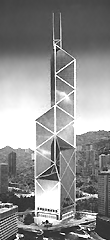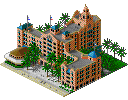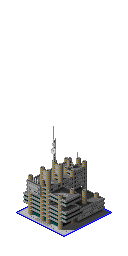 |
| Home |
| New SCURK |
| Asia SCURK |
| Historic Japan SCURK |
| Modern Japan SCURK |
| Russia SCURK |
| SCURK'em |
| Graphic Tips |
| Tokyo |
| Links |
|
PCX downloads are compressed into ZIP files. You will need a PKUNZIP utility to uncompress them. |
THE SOJOT COLLECTION
|
NEW |
|
Royal Hawaiian Hotel Download the Royal Hawaiian Hotel: Download DOS PCX archive as RohawPCX.zip (12064 bytes)
The queen of Waikiki's beachside luxury hotels, the Royal Hawaiian Hotel ranks among the most popular landmarks in Honolulu and is affectionately known locally as the "Pink Palace of the Pacific" or simply the "Pink Palace." Opened in 1927 as a stopping place for steamship passengers travelling on the Matson Navigation Company's three luxury liners, this elegant boasted rococo lobbies, a theater ballroom decorated in Egyptian themes, 400 guestrooms with Chinese and Persian carpets along with lanai wicker funishings, and waitresses dressed in quaint Japanese kimonos, all set in a luminously pink, Spanish-Moorish styled building. Among the top hotels in the world, it has been the playground of royal princes and Hollywood movie stars. The government took over the Royal Hawaiian during World War II, using the grand hotel as a rest and recreation center for naval pilots and submarine crews. During this time, the hotel's Japanese cultural influences were stripped, while barbed wire was stretched all across Waikiki Beach. After the war, the popular hotel reopened with a weeklong gala celebration in 1947. A refubishing had replaced the rococo ceiling and informal wicker funiture with cool monotones, mahogany furniture, and tropical prints. The hotel was bought from Matson by the ITT Sheraton group in 1959 and later by the Kyo-ya Company in 1975, but it continues to be managed by Sheraton. With the modern boom of Waikiki tourism, the historic hotel with its charming gardens and Coconut Grove are now flanked by larger, more modern hotel towers. Sheraton would also add a 16-story modern tower to the Royal Hawaiian, bringing the number of guest rooms to 576. However, despite the modern changes, the Royal Hawaiian still remains a top destination for visitors seeking a more nostalgic experience of Waikiki.
The SCURK version of the Royal Hawaiian Hotel is a multi-tile image consisting of two hotel sections and two beach tiles. I have tried my best to give the false facade on the second hotel section a realistic look, though it will be hidden when the two sections are combined. I like to alternate the beach tiles, and I would use them as replacements for the small park and the water pump. Ideally, the water pump along the shore will provide simcities with water, while the small parks will aid in boosting beachside land values. Hopefully, the people on the beaches are sufficiently random looking enough that they don't make too many obvious patterns, but if a long beach is desired, more tiles with different patterns should definitely be added. I'm not sure I like my palm trees just yet, but I'm just tired of struggling with them.
Yamanashi Press and Broadcasting Centre Download the Yamanashi Press and Broadcasting Centre: Download DOS PCX archive as YamanPCX.zip (3574 bytes)
Also called the Kofu Communications Centre, this building is the main central home for the mass communication media of the entire the Yamanashi region. Within its bulk are a radio station, newspaper head offices, commercial offices, and ground floor shopping areas. Designed by Kenzo Tange and completed in 1966, the Kofu Communications Centre represents one of the few successful buildings inspired by the Japanese Metabolist movement, which called for architecture and cities to represent organic processes of growth and change. Most Metabolist designs used trees as analogies, with a main structure representing a trunk or structural branches onto which smaller living and working units were attached like leaves or pods. Ideally, this smaller units could be removed, interchanged, or expanded as necessary, thus capturing a sense of evolution. In this rather subdued example, Tange provides 16 main tubular service cores, between which layers of occupiable space is inserted, almost hung from corner clips attached to the tubes frame. The entire composition, makes the building seem incomplete, and unused clips suggest that further vertical and horizontal expansion with more inserted layers of floors could be possible. |
This Page Last Updated July 20, 2000.
©1996-2000 by Lee Sojot
leesojot@hotmail.com
| Home |
| New SCURK |
| Asia SCURK |
| Historic Japan SCURK |
| Modern Japan SCURK |
| Russia SCURK |
| SCURK'em |
| Graphic Tips |
| Tokyo |
| Links |





